
- 阻害剤
- 研究分野別
- PI3K/Akt/mTOR
- Epigenetics
- Methylation
- Immunology & Inflammation
- Protein Tyrosine Kinase
- Angiogenesis
- Apoptosis
- Autophagy
- ER stress & UPR
- JAK/STAT
- MAPK
- Cytoskeletal Signaling
- Cell Cycle
- TGF-beta/Smad
- 化合物ライブラリー
- Popular Compound Libraries
- Customize Library
- Clinical and FDA-approved Related
- Bioactive Compound Libraries
- Inhibitor Related
- Natural Product Related
- Metabolism Related
- Cell Death Related
- By Signaling Pathway
- By Disease
- Anti-infection and Antiviral Related
- Neuronal and Immunology Related
- Fragment and Covalent Related
- FDA-approved Drug Library
- FDA-approved & Passed Phase I Drug Library
- Preclinical/Clinical Compound Library
- Bioactive Compound Library-I
- Bioactive Compound Library-II
- Kinase Inhibitor Library
- Express-Pick Library
- Natural Product Library
- Human Endogenous Metabolite Compound Library
- Alkaloid Compound LibraryNew
- Angiogenesis Related compound Library
- Anti-Aging Compound Library
- Anti-alzheimer Disease Compound Library
- Antibiotics compound Library
- Anti-cancer Compound Library
- Anti-cancer Compound Library-Ⅱ
- Anti-cancer Metabolism Compound Library
- Anti-Cardiovascular Disease Compound Library
- Anti-diabetic Compound Library
- Anti-infection Compound Library
- Antioxidant Compound Library
- Anti-parasitic Compound Library
- Antiviral Compound Library
- Apoptosis Compound Library
- Autophagy Compound Library
- Calcium Channel Blocker LibraryNew
- Cambridge Cancer Compound Library
- Carbohydrate Metabolism Compound LibraryNew
- Cell Cycle compound library
- CNS-Penetrant Compound Library
- Covalent Inhibitor Library
- Cytokine Inhibitor LibraryNew
- Cytoskeletal Signaling Pathway Compound Library
- DNA Damage/DNA Repair compound Library
- Drug-like Compound Library
- Endoplasmic Reticulum Stress Compound Library
- Epigenetics Compound Library
- Exosome Secretion Related Compound LibraryNew
- FDA-approved Anticancer Drug LibraryNew
- Ferroptosis Compound Library
- Flavonoid Compound Library
- Fragment Library
- Glutamine Metabolism Compound Library
- Glycolysis Compound Library
- GPCR Compound Library
- Gut Microbial Metabolite Library
- HIF-1 Signaling Pathway Compound Library
- Highly Selective Inhibitor Library
- Histone modification compound library
- HTS Library for Drug Discovery
- Human Hormone Related Compound LibraryNew
- Human Transcription Factor Compound LibraryNew
- Immunology/Inflammation Compound Library
- Inhibitor Library
- Ion Channel Ligand Library
- JAK/STAT compound library
- Lipid Metabolism Compound LibraryNew
- Macrocyclic Compound Library
- MAPK Inhibitor Library
- Medicine Food Homology Compound Library
- Metabolism Compound Library
- Methylation Compound Library
- Mouse Metabolite Compound LibraryNew
- Natural Organic Compound Library
- Neuronal Signaling Compound Library
- NF-κB Signaling Compound Library
- Nucleoside Analogue Library
- Obesity Compound Library
- Oxidative Stress Compound LibraryNew
- Phenotypic Screening Library
- PI3K/Akt Inhibitor Library
- Protease Inhibitor Library
- Protein-protein Interaction Inhibitor Library
- Pyroptosis Compound Library
- Small Molecule Immuno-Oncology Compound Library
- Mitochondria-Targeted Compound LibraryNew
- Stem Cell Differentiation Compound LibraryNew
- Stem Cell Signaling Compound Library
- Natural Phenol Compound LibraryNew
- Natural Terpenoid Compound LibraryNew
- TGF-beta/Smad compound library
- Traditional Chinese Medicine Library
- Tyrosine Kinase Inhibitor Library
- Ubiquitination Compound Library
-
Cherry Picking
You can personalize your library with chemicals from within Selleck's inventory. Build the right library for your research endeavors by choosing from compounds in all of our available libraries.
Please contact us at info@selleck.co.jp to customize your library.
You could select:
- 抗体
- 新製品
- お問い合わせ
FXR
FXR製品
- All (34)
- FXR阻害剤 (2)
- FXR活性剤(1)
- FXR拮抗剤(2)
- FXR作動薬(14)
- FXRモジュレータ(1)
- 新製品
| 製品コード | 製品名称 | 製品説明 | 文献中Selleckの製品使用例 | お客様のフィードバック |
|---|---|---|---|---|
| S2449 | Forskolin (Colforsin) | コルホルチン (Forskolin (Colforsin)) は、広範な細胞腫における真核生物のアデニル酸シクラーゼ (adenylate cyclase, AC) の遍在する活性化因子であり、細胞生理学の研究において cAMP のレベルを上げるために一般的に使用されています。ホルスコリン (Forskolin) は、PXR と FXR も活性化します。 ホルスコリンはオートファジー (autophagy) を刺激します。 |
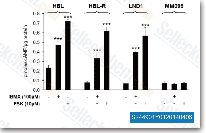
|
|
| S2782 | GW4064 | GW4064 is an agonist of farnesoid X receptor (FXR) with EC50 of 65 nM in CV1 cell line and displays no activity at other nuclear receptors at concentrations up to 1 μM. GW4064 stimulates autophagy in MCF-7 cells. |
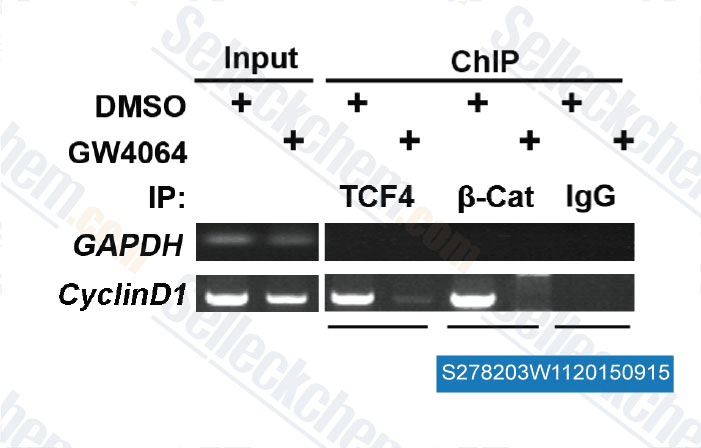
|
|
| S7076 | T0901317 | T0901317 is a potent and selective agonist for both LXR and FXR, with EC50 of ~50 nM and 5 μM, respectively. T0901317 is a dual inverse agonist of RORα and RORγ with Ki of 132 nM and 51 nM, respectively. T0901317 significantly suppresses cell proliferation and induces apoptosis. |
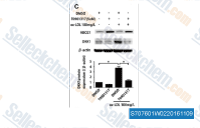
|
|
| S7660 | Obeticholic Acid (INT-747) | Obeticholic Acid (INT-747) is a potent and selective farnesoid X receptor (FXR) agonist with EC50 of 99 nM. Obeticholic Acid inhibits autophagy. Phase 3. |
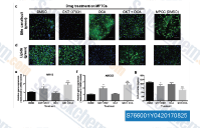
|
|
| S4003 | Lithocholic acid | Lithocholic acid is a toxic secondary bile acid, causes intrahepatic cholestasis, has tumor-promoting activity, its toxic effect can be protected after it activates the vitamin D receptor, PXR and FXR. | ||
| S3792 | Guggulsterone E&Z | Guggulsterone is one of the active constituent of Commiphora mukul. It occurs in two isomeric forms, namely Z-GS and E-GS. Guggulsterone act as antagonist ligands for the bile acid receptor, farnesoid X receptor, and as active ingredients responsible for the hypolipidemic activity. | ||
| S2694 | Turofexorate Isopropyl (XL335) | Turofexorate Isopropyl (XL335, Fxr 450) is a potent, selective FXR agonist with EC50 of 4 nM, highly selective versus other nuclear receptors, such as LXR, PPAR, ER and etc. Phase 1. |
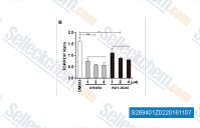
|
|
| S1843 | Chenodeoxycholic Acid | Chenodeoxycholic Acid (Chenodiol, Chenodesoxycholic acid, Chenocholic acid,CDCA) is a naturally occurring human bile acid, and inhibits production of cholesterol in the liver and absorption in the intestines. | ||
| S1643 | Ursodiol | Ursodiol (Ursodeoxycholic acid, UDCA) reduces cholesterol absorption and is used to dissolve (cholesterol) gallstones. (IC50=0.22 μM) | ||
| S4129 | Sevelamer HCl | Sevelamer HCl is a phosphate binding drug used to treat hyperphosphatemia via binding to dietary phosphate and prevents its absorption. | ||
| S0033 | BAR502 | BAR502 (Compound 30) is a dual FXR and GPBAR1 agonist with IC50 values of 2 μM and 0.4 μM, respectively. | ||
| S0037 | Nidufexor (LMB-763) | Nidufexor (LMB763) is an agonist of farnesoid X receptor (FXR). | ||
| S8733 | Tropifexor (LJN452) | Tropifexor (LJN452) is a novel and highly potent agonist of FXR with EC50 of 0.2 nM in HTRF assay. It shows no significant off-target activity against a broad panel of enzyme, ion channel, nuclear receptor, and GPCR (>10000-fold selectivity for FXR). | ||
| E4873 | Mebhydroline | Mebhydroline acts as a selective antagonist of farnesoid X receptor (FXR). Mebhydrolin improves blood glucose balance in in vivo mice models by inhibiting hepatic gluconeogenesis through the FXR/miR-22-3p/PI3K/AKT/FoxO1 pathway and enhancing glycogen synthesis. It also acts as a specific antagonist of histamine H1 receptor. It has potential for its use in the treatment of Type 2 diabetes mellitus (T2DM). | ||
| S0874 | Vonafexor (EYP001) | Vonafexor (EYP001, PLX007) is a novel non-bile acid, selective, second generation farnesoid X receptor (FXR) agonist. | ||
| S6547 | Cilofexor (GS-9674) | Cilofexor(GS-9674) is a potent, selective oral agonist of farnesoid X receptor (FXR) with an EC50 of 43 nM. It has demonstrated anti-inflammatory, antifibrotic effects, and reduced portal pressure in preclinical liver fibrosis models, showing potential therapeutic benefit for primary sclerosing cholangitis (PSC) and nonalcoholic steatohepatitis (NASH) research. | ||
| E5874New | INT-767 | INT-767 is a dual agonist of farnesoid X receptor (FXR)/TGR5 with an EC50 of 0.033 μM and 0.67 μM, respectively. It significantly improves serum liver enzymes, hepatic inflammation, and biliary fibrosis, while inducing bile flow and biliary HCO₃⁻ output, making it a promising tool for chronic cholangiopathy research. | ||
| S0403 | LY2562175 | LY2562175 is a potent and selective agonist of FXR. LY2562175 promotes transcriptional activation of human FXR in a cell-based cotransfection assay with EC50 of 193 nM. | ||
| S6413 | fexaramine | Fexaramine is a potent, selective farnesoid X receptor (FXR) agonist with an EC50 of 25 nM and it displays no activity at hRXRα, hPPARα, hPPARγ, hPPARδ, mPXR, hPXR, hLXRα, hTRβ, hRARβ, mCAR, mERRγ and hVDR receptors. | ||
| E4617New | Gly-β-MCA | 胆汁酸であるGly - β - MCAは、強力で安定的な、腸選択的かつ経口で生物学的活性を有するファルネソイドX受容体(FXR)阻害剤であり、代謝障害の治療薬の候補となり得る。 | ||
| S2782 | GW4064 | GW4064 is an agonist of farnesoid X receptor (FXR) with EC50 of 65 nM in CV1 cell line and displays no activity at other nuclear receptors at concentrations up to 1 μM. GW4064 stimulates autophagy in MCF-7 cells. |

|
|
| S7076 | T0901317 | T0901317 is a potent and selective agonist for both LXR and FXR, with EC50 of ~50 nM and 5 μM, respectively. T0901317 is a dual inverse agonist of RORα and RORγ with Ki of 132 nM and 51 nM, respectively. T0901317 significantly suppresses cell proliferation and induces apoptosis. |

|
|
| S7660 | Obeticholic Acid (INT-747) | Obeticholic Acid (INT-747) is a potent and selective farnesoid X receptor (FXR) agonist with EC50 of 99 nM. Obeticholic Acid inhibits autophagy. Phase 3. |

|
|
| S4003 | Lithocholic acid | Lithocholic acid is a toxic secondary bile acid, causes intrahepatic cholestasis, has tumor-promoting activity, its toxic effect can be protected after it activates the vitamin D receptor, PXR and FXR. | ||
| S2694 | Turofexorate Isopropyl (XL335) | Turofexorate Isopropyl (XL335, Fxr 450) is a potent, selective FXR agonist with EC50 of 4 nM, highly selective versus other nuclear receptors, such as LXR, PPAR, ER and etc. Phase 1. |

|
|
| S1843 | Chenodeoxycholic Acid | Chenodeoxycholic Acid (Chenodiol, Chenodesoxycholic acid, Chenocholic acid,CDCA) is a naturally occurring human bile acid, and inhibits production of cholesterol in the liver and absorption in the intestines. | ||
| S0033 | BAR502 | BAR502 (Compound 30) is a dual FXR and GPBAR1 agonist with IC50 values of 2 μM and 0.4 μM, respectively. | ||
| S0037 | Nidufexor (LMB-763) | Nidufexor (LMB763) is an agonist of farnesoid X receptor (FXR). | ||
| S8733 | Tropifexor (LJN452) | Tropifexor (LJN452) is a novel and highly potent agonist of FXR with EC50 of 0.2 nM in HTRF assay. It shows no significant off-target activity against a broad panel of enzyme, ion channel, nuclear receptor, and GPCR (>10000-fold selectivity for FXR). | ||
| S0874 | Vonafexor (EYP001) | Vonafexor (EYP001, PLX007) is a novel non-bile acid, selective, second generation farnesoid X receptor (FXR) agonist. | ||
| S6547 | Cilofexor (GS-9674) | Cilofexor(GS-9674) is a potent, selective oral agonist of farnesoid X receptor (FXR) with an EC50 of 43 nM. It has demonstrated anti-inflammatory, antifibrotic effects, and reduced portal pressure in preclinical liver fibrosis models, showing potential therapeutic benefit for primary sclerosing cholangitis (PSC) and nonalcoholic steatohepatitis (NASH) research. | ||
| E5874New | INT-767 | INT-767 is a dual agonist of farnesoid X receptor (FXR)/TGR5 with an EC50 of 0.033 μM and 0.67 μM, respectively. It significantly improves serum liver enzymes, hepatic inflammation, and biliary fibrosis, while inducing bile flow and biliary HCO₃⁻ output, making it a promising tool for chronic cholangiopathy research. | ||
| S0403 | LY2562175 | LY2562175 is a potent and selective agonist of FXR. LY2562175 promotes transcriptional activation of human FXR in a cell-based cotransfection assay with EC50 of 193 nM. | ||
| S6413 | fexaramine | Fexaramine is a potent, selective farnesoid X receptor (FXR) agonist with an EC50 of 25 nM and it displays no activity at hRXRα, hPPARα, hPPARγ, hPPARδ, mPXR, hPXR, hLXRα, hTRβ, hRARβ, mCAR, mERRγ and hVDR receptors. | ||
| S4129 | Sevelamer HCl | Sevelamer HCl is a phosphate binding drug used to treat hyperphosphatemia via binding to dietary phosphate and prevents its absorption. | ||
| E4617New | Gly-β-MCA | 胆汁酸であるGly - β - MCAは、強力で安定的な、腸選択的かつ経口で生物学的活性を有するファルネソイドX受容体(FXR)阻害剤であり、代謝障害の治療薬の候補となり得る。 | ||
| S2449 | Forskolin (Colforsin) | コルホルチン (Forskolin (Colforsin)) は、広範な細胞腫における真核生物のアデニル酸シクラーゼ (adenylate cyclase, AC) の遍在する活性化因子であり、細胞生理学の研究において cAMP のレベルを上げるために一般的に使用されています。ホルスコリン (Forskolin) は、PXR と FXR も活性化します。 ホルスコリンはオートファジー (autophagy) を刺激します。 |

|
|
| S3792 | Guggulsterone E&Z | Guggulsterone is one of the active constituent of Commiphora mukul. It occurs in two isomeric forms, namely Z-GS and E-GS. Guggulsterone act as antagonist ligands for the bile acid receptor, farnesoid X receptor, and as active ingredients responsible for the hypolipidemic activity. | ||
| E4873 | Mebhydroline | Mebhydroline acts as a selective antagonist of farnesoid X receptor (FXR). Mebhydrolin improves blood glucose balance in in vivo mice models by inhibiting hepatic gluconeogenesis through the FXR/miR-22-3p/PI3K/AKT/FoxO1 pathway and enhancing glycogen synthesis. It also acts as a specific antagonist of histamine H1 receptor. It has potential for its use in the treatment of Type 2 diabetes mellitus (T2DM). | ||
| S2782 | GW4064 | GW4064 is an agonist of farnesoid X receptor (FXR) with EC50 of 65 nM in CV1 cell line and displays no activity at other nuclear receptors at concentrations up to 1 μM. GW4064 stimulates autophagy in MCF-7 cells. |

|
|
| S7076 | T0901317 | T0901317 is a potent and selective agonist for both LXR and FXR, with EC50 of ~50 nM and 5 μM, respectively. T0901317 is a dual inverse agonist of RORα and RORγ with Ki of 132 nM and 51 nM, respectively. T0901317 significantly suppresses cell proliferation and induces apoptosis. |

|
|
| S7660 | Obeticholic Acid (INT-747) | Obeticholic Acid (INT-747) is a potent and selective farnesoid X receptor (FXR) agonist with EC50 of 99 nM. Obeticholic Acid inhibits autophagy. Phase 3. |

|
|
| S4003 | Lithocholic acid | Lithocholic acid is a toxic secondary bile acid, causes intrahepatic cholestasis, has tumor-promoting activity, its toxic effect can be protected after it activates the vitamin D receptor, PXR and FXR. | ||
| S2694 | Turofexorate Isopropyl (XL335) | Turofexorate Isopropyl (XL335, Fxr 450) is a potent, selective FXR agonist with EC50 of 4 nM, highly selective versus other nuclear receptors, such as LXR, PPAR, ER and etc. Phase 1. |

|
|
| S1843 | Chenodeoxycholic Acid | Chenodeoxycholic Acid (Chenodiol, Chenodesoxycholic acid, Chenocholic acid,CDCA) is a naturally occurring human bile acid, and inhibits production of cholesterol in the liver and absorption in the intestines. | ||
| S0033 | BAR502 | BAR502 (Compound 30) is a dual FXR and GPBAR1 agonist with IC50 values of 2 μM and 0.4 μM, respectively. | ||
| S0037 | Nidufexor (LMB-763) | Nidufexor (LMB763) is an agonist of farnesoid X receptor (FXR). | ||
| S8733 | Tropifexor (LJN452) | Tropifexor (LJN452) is a novel and highly potent agonist of FXR with EC50 of 0.2 nM in HTRF assay. It shows no significant off-target activity against a broad panel of enzyme, ion channel, nuclear receptor, and GPCR (>10000-fold selectivity for FXR). | ||
| S0874 | Vonafexor (EYP001) | Vonafexor (EYP001, PLX007) is a novel non-bile acid, selective, second generation farnesoid X receptor (FXR) agonist. | ||
| S6547 | Cilofexor (GS-9674) | Cilofexor(GS-9674) is a potent, selective oral agonist of farnesoid X receptor (FXR) with an EC50 of 43 nM. It has demonstrated anti-inflammatory, antifibrotic effects, and reduced portal pressure in preclinical liver fibrosis models, showing potential therapeutic benefit for primary sclerosing cholangitis (PSC) and nonalcoholic steatohepatitis (NASH) research. | ||
| E5874New | INT-767 | INT-767 is a dual agonist of farnesoid X receptor (FXR)/TGR5 with an EC50 of 0.033 μM and 0.67 μM, respectively. It significantly improves serum liver enzymes, hepatic inflammation, and biliary fibrosis, while inducing bile flow and biliary HCO₃⁻ output, making it a promising tool for chronic cholangiopathy research. | ||
| S0403 | LY2562175 | LY2562175 is a potent and selective agonist of FXR. LY2562175 promotes transcriptional activation of human FXR in a cell-based cotransfection assay with EC50 of 193 nM. | ||
| S6413 | fexaramine | Fexaramine is a potent, selective farnesoid X receptor (FXR) agonist with an EC50 of 25 nM and it displays no activity at hRXRα, hPPARα, hPPARγ, hPPARδ, mPXR, hPXR, hLXRα, hTRβ, hRARβ, mCAR, mERRγ and hVDR receptors. | ||
| S1643 | Ursodiol | Ursodiol (Ursodeoxycholic acid, UDCA) reduces cholesterol absorption and is used to dissolve (cholesterol) gallstones. (IC50=0.22 μM) | ||
| E5874New | INT-767 | INT-767 is a dual agonist of farnesoid X receptor (FXR)/TGR5 with an EC50 of 0.033 μM and 0.67 μM, respectively. It significantly improves serum liver enzymes, hepatic inflammation, and biliary fibrosis, while inducing bile flow and biliary HCO₃⁻ output, making it a promising tool for chronic cholangiopathy research. | ||
| E4617New | Gly-β-MCA | 胆汁酸であるGly - β - MCAは、強力で安定的な、腸選択的かつ経口で生物学的活性を有するファルネソイドX受容体(FXR)阻害剤であり、代謝障害の治療薬の候補となり得る。 | ||
| E5874New | INT-767 | INT-767 is a dual agonist of farnesoid X receptor (FXR)/TGR5 with an EC50 of 0.033 μM and 0.67 μM, respectively. It significantly improves serum liver enzymes, hepatic inflammation, and biliary fibrosis, while inducing bile flow and biliary HCO₃⁻ output, making it a promising tool for chronic cholangiopathy research. |
